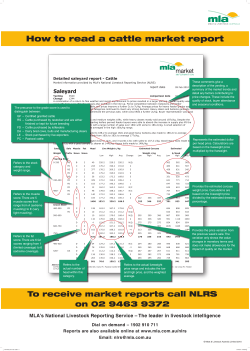
Document 247092
Why Cattle Mineral Supplements
Don’t Meet the Needs of Goats
By Jackie Nix
For years goat producers have had to “make due” with available mineral supplements since very few, if
any goat-specific products were available. Most went through a phase of feeding sheep & goat minerals
but then quit after copper deficiency problems or warnings from fellow goat producers. After that, the
next logical progression was to use cattle or horse mineral. Many of you may even still be feeding cattle
or horse mineral to your goats. I hope to give some food for thought on the use of cattle or horse mineral
for goats in the course of this article.
Relatively speaking, the mineral needs of goats are similar to that of cattle. Both species require the
same minerals in roughly the same proportions. As an example a 1000 lb. beef cow requires roughly 1040 g of calcium per day and a 200 lb. meat doe requires roughly 0.5 – 25 g of calcium per day. The cow
requires roughly 30 – 90 mg of copper and the doe requires roughly 25 - 55 mg of copper. As you can
see they have similar needs. However, the key difference is that cattle consume a much greater amount
(average 2 to 8 oz of mineral supplement per head per day) than goats (0.25 to 1 oz of mineral
supplement per head per day). Even though the mineral requirements of cattle and goats are very similar,
the expected intake of supplement of each is drastically different. Because goats eat so much less than
cattle, they need a much more concentrated mineral supplement than cattle.
Most cattle supplements are designed for 2 to 8 oz. consumption rates, depending on the type of
supplement (i.e., loose mineral, cooked block, pressed block, etc.). Conversely, a goat can be expected
to consume from 0.3 to 1 oz. of mineral supplement depending on the size, breed and mineral nutrition
status of the goat. We can't expect a goat to consume as much supplement as a cow, therefore a cattle
product will deliver much less of the target minerals than a more concentrated goat product.
As an example let’s look at a cattle loose mineral supplement with a copper concentration of 200 ppm
and a target intake level of 5 oz. To determine the amount of copper delivered, multiply 200 ppm by 5
oz and divide by 35.2 (conversion factor) to arrive at 28 mg. Therefore, five ounces of this product
delivers 28 mg of copper to the animal. Problem is that we can't realistically expect a goat to consume 5
oz. of a loose mineral supplement. At 1 oz. consumption (a more realistic expectation) this product will
deliver 5.7 mg of copper ({200 ppm X 1 oz} ⁄ 35.2 = 5.7 mg). As you can see, at a more realistic
consumption level, this mineral will not meet the copper requirements of this doe (25-55 mg of copper).
What if you are currently using cattle or horse mineral and are happy with the results you are getting?
While I’m as much a fan of the if-it-ain’t-broke-don’t-fix-it philosophy as the next person, you may
want to consider experimentation with a goat mineral supplement to see if your production levels
improve. Optimum mineral nutrition can positively influence production parameters such as number of
days open, hoof health, immunity and average daily gain, among others. It is likely that the goats fed
cattle or horse mineral are not receiving the optimum mineral levels necessary for maximum
performance up to their genetic potential.
In conclusion, cattle and horse mineral supplements are not concentrated enough to deliver 100% of the
mineral nutrition needs for goats. Whenever possible use a mineral supplement designed specifically for
goats such as the Sweetlix 16:8 Meat Maker or Sweetlix Caprine Magnum-Milk supplements.
However, when no other products are available, cattle or horse minerals are better than no
supplementation at all and will supply some needed copper.
Jackie Nix is a nutritionist for Sweetlix (http://www.sweetlix.com. You can contact her at jnix@sweetlix.com or 1-800-3251486 for questions or to learn more about the Sweetlix line of mineral and protein supplements for goats, cattle, horses,
sheep and wildlife.
February 2002
© Copyright 2025




















